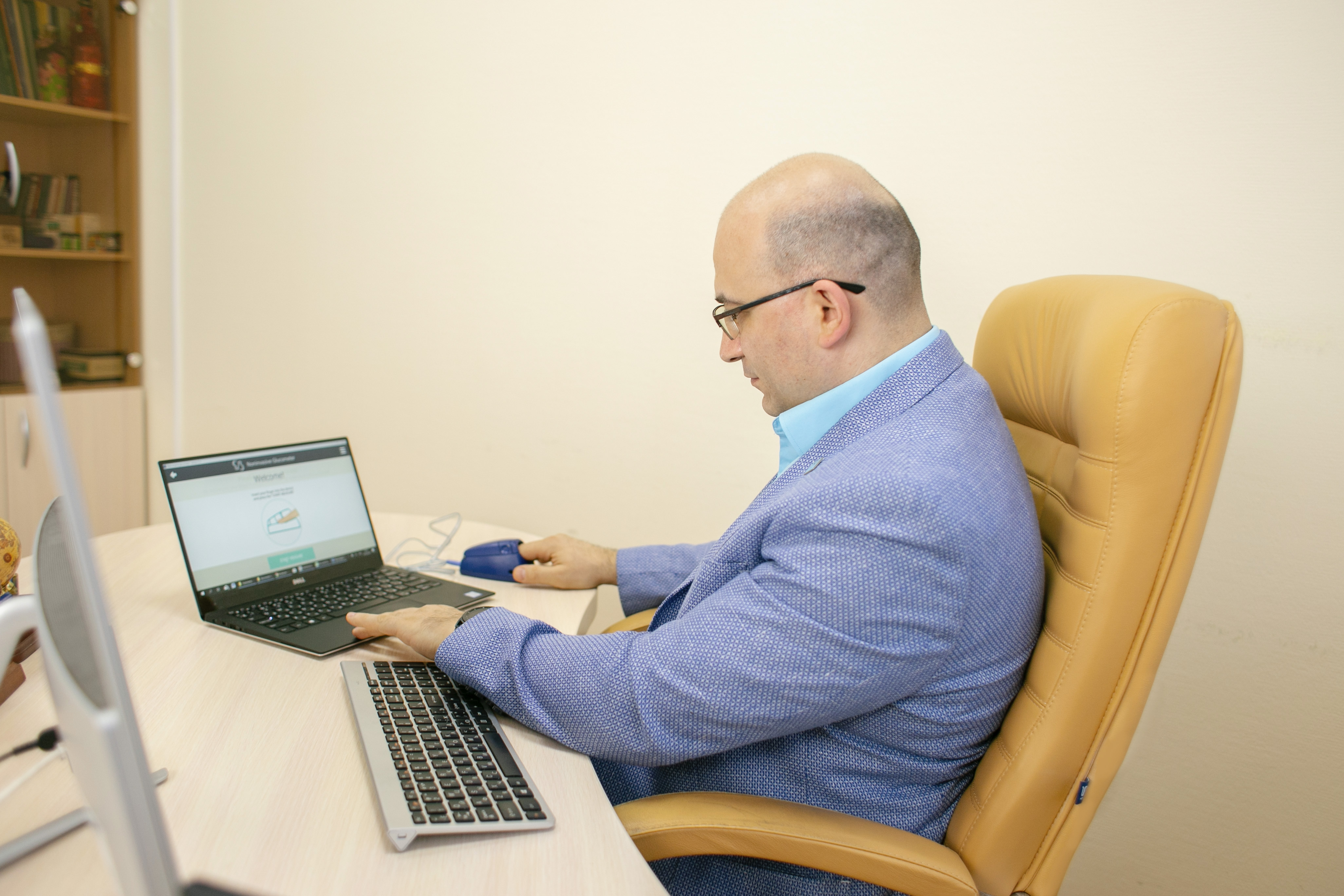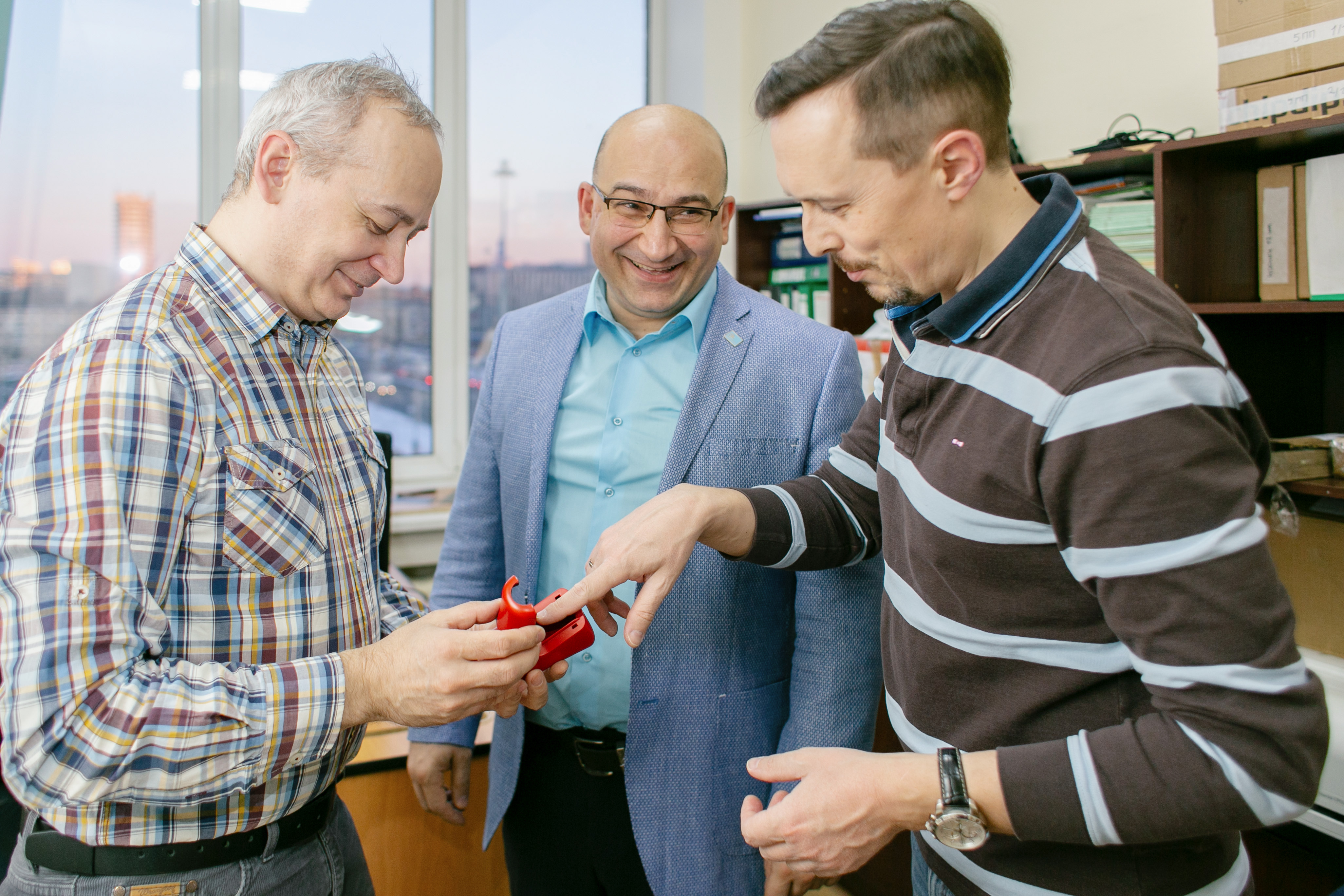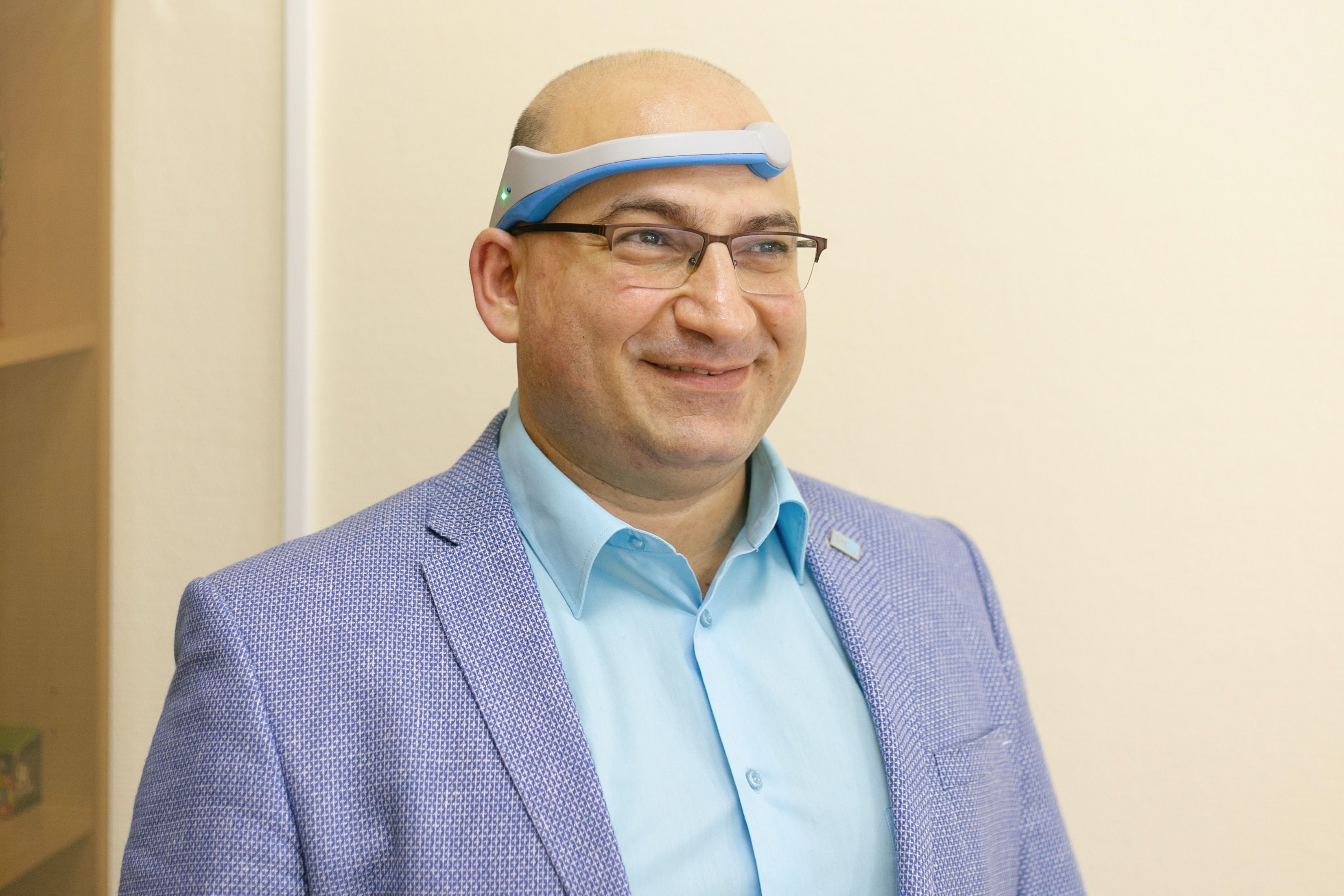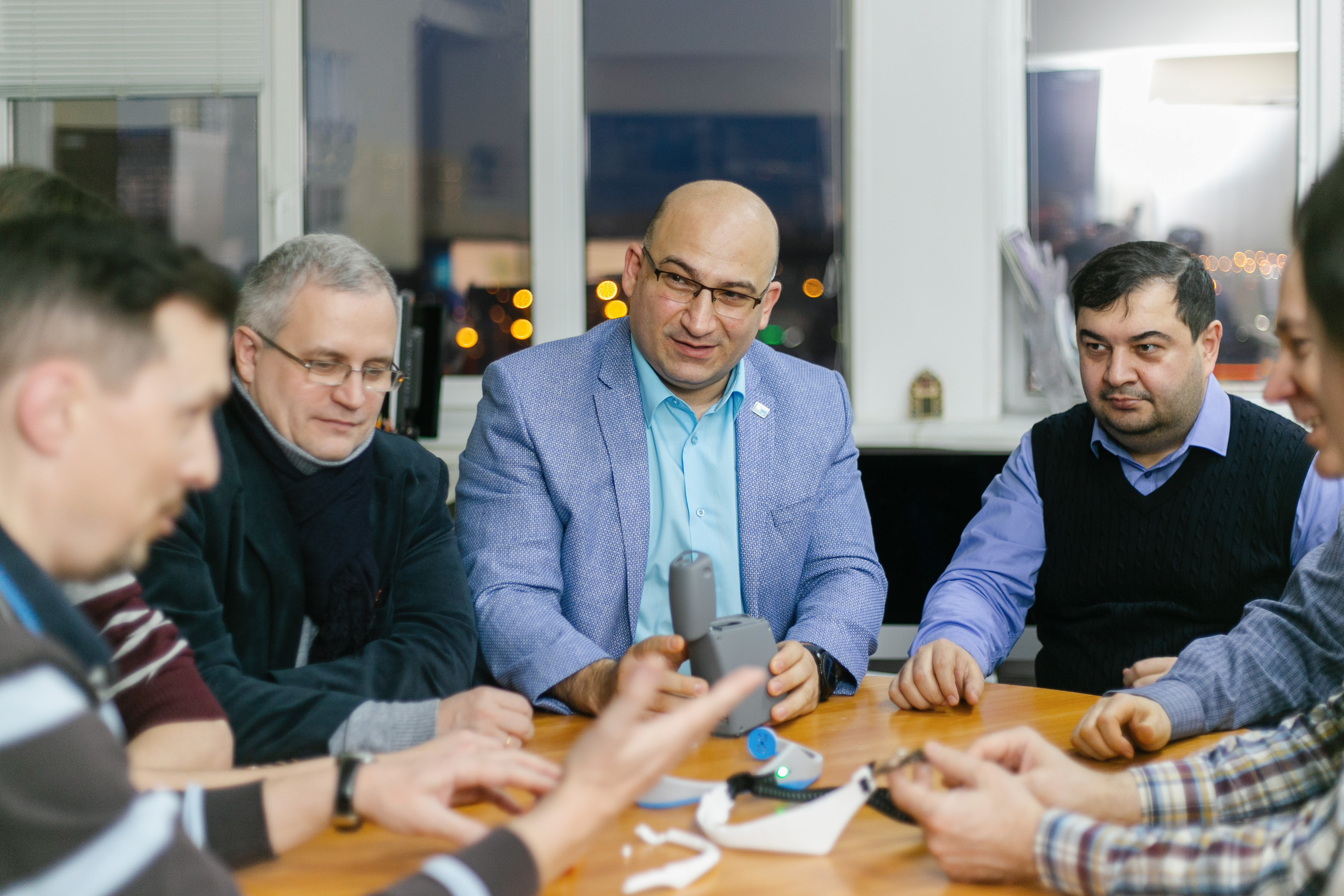Brain Beat was founded in 2014 as a startup working at the intersection of medicine and IT.The main direction of the company
 Photo: Egor Tsvetkov / Haytek
Photo: Egor Tsvetkov / Haytek
Founder and CEO of Brain BitEdward Kryzhanovsky became interested in the problem of diabetics after meeting with doctors at one of the meetings on his current work - at that time he was working on other projects based on infrared spectroscopy. From doctors, Kryzhanovsky heard frightening statistics - in Russia there are about 5 million people with diabetes, and all over the world there are almost 422 million people suffering from diabetes. Moreover, the number of diabetics doubles every twelve years. Every year, about 1.6 million people die from diabetes on the planet, and by 2030, every seventh death will be caused by this disease. Life for diabetics is also complicated by the way they monitor their health. To check the level of glucose in the blood, you have to prick the skin every time, which causes not only physical discomfort, but also the risk of infection, and therefore limited use: it is hardly worth pricking an unwashed finger on the street.
Kryzhanovsky decided that the development of non-invasiveA diabetic device can be a great example of how physics helps medicine. Edward graduated from the Big University in St. Petersburg in the direction of "Physics of Elementary Particles". And from the moment of graduation, he dreamed of continuing Einstein's work: to find a single beginning between the fundamental interactions of the physical world. Great scientists, including Stephen Hawking, did similar research, but the practical implementation of these theories is a matter for the distant future. Whereas the solution of global problems related to human health requires practical and concrete steps now. Edward decided that his own high-tech business is the best way to apply his knowledge and experience. The first team of "Brain Beat" includes several leading doctors, programmers and engineers, most of whom Edward met while studying at St. Petersburg State University. This is how a startup for the creation of a non-invasive and atraumatic glucometer appeared.
On the verge of physics and biology
While still in graduate school, Edward chose biophysics for his scientific career. According to him, this direction allows us to see the real results of scientific developments.
At the end of the 90s, Kryzhanovsky developedtechnology that can distinguish between synthetic and natural essential oils. The method is still used in the division of the Estée Lauder company, specializing in the production of natural cosmetics. Edward, as a promising scientist, was invited to an internship in Minnesota, USA. But after three months of practice, despite the brilliant American prospects, Edward returned to Russia, because he wanted to develop domestic science.
In 2003, Kryzhanovsky defended his dissertation, andfour years later, together with his friend, also a graduate of the physics department of St. Petersburg State University, Armen Grigoryan, he founded the company Bioenergy Technologies, which was developing complexes for teaching people to control their own emotions and mental state. The hardware-software device developed by Kryzhanovsky and Grigoryan simulated a gaming situation, and the subject controlled the figure on the screen without using a mouse, keyboard or other physical device. The influence on the character was carried out only through changes in consciousness.
 Photo: Egor Tsvetkov / Haytek
Photo: Egor Tsvetkov / Haytek
Kryzhanovsky was responsible for the concept, mathematicalmodels, computed algorithms, and Grigorian wrote software codes and developed software. The project involved doctors, engineers and designers. One of the methods - the neural interface based on IR-spectroscopy is today used at the Institute of Brain RAS. In addition, infrared spectroscopy is the only non-surgical method to determine the state of the brain while observing the dynamics of the oxygen level in the vessels. The cost of the device is hundreds of times lower than the installation for MRI, and the range of tasks is comparable.
Infrared spectroscopy for cancer diagnosis
In medicine, infrared spectroscopyused as a tool for studying tissue biochemistry. IR spectroscopy, in particular, is sensitive to the structure and concentration of macromolecules (proteins, DNA) and is much less applicable for detecting small molecules that are found in cells at low concentrations. Changes in the IR spectra of biological materials indicate pathologies associated with impaired biochemical composition of the sample. For example, cancer changes are often associated with the presence of several nuclei in a cell. Accordingly, infrared spectroscopy shows diagnostic changes associated with increased absorption of nucleic acids.
Data collection and interpretation is possible eitherthe classical method (the study of the intensity of the characteristic absorption bands from the spectra), or by constructing spatial maps of the intensity of frequencies. In the latter case, an infrared microscope is used, which allows taking spectra sequentially from specified points of the sample, and then displaying the result as a three-dimensional graph.
The advantage of this research method isdevice versatility: to study a wide range of disorders in various tissues does not require a serious configuration adjustment or the use of special detectors and reagents.
For almost 12 years of work, the Kryzhanovsky team often people have developed six medical devices that are used in more than 30 countries, and out of 2,000 clients, about 50% are foreign clinics. Funds from the sale of technologies allowed the company to engage in science and new developments without third-party investments in the initial stages.
 Photo: Egor Tsvetkov / Haytek
Photo: Egor Tsvetkov / Haytek
Advanced Emotion Control Devicenow exists in the form of a gadget accessible to the masses. The scientist himself claims: having learned to manage emotions, a person in a stressful situation is able to move into a relaxed state, without allowing stress to disrupt the functioning of the body. Consciously switching the phases of brain activity allows you to get enough sleep much faster.
Physics in Endocrinology
There is no cure for diabetes todaydoctors only give recommendations on nutrition and prescribe drugs to lower blood glucose levels. The second type of diabetes does not require insulin shots, whereas the control of a disease of the first type is carried out by subcutaneous injection of insulin. The dosage of the drug is determined on the basis of indicators of blood sugar. Until recently, it was only possible to measure the glucose level by an invasive method: pierce the skin, apply blood to the test strip, and get a reading from the meter. Type 1 diabetes requires you to control your sugar level several times a day.
Invasive method for determining sugar levelscreates physical discomfort: pain and roughening of the fingertips. High probability of infection. Children with diabetes find it psychologically difficult to come to terms with the need to constantly experience pain from injections.

The development of a non-invasive blood glucose meter is underway.for decades, but no impressive success has been achieved. And in the media, publications appear at all that non-invasive devices are just a myth and a “divorce” for money. In Russia, about ten teams of scientists are employed in the search for methods. To solve this ambitious scientific task, Kryzhanovsky in 2014 created the Brain Beat startup. Now the company employs 11 people. Initially, biophysicists, who worked on the device, did work at home.
From Chile to Japan
After studying the work of predecessors and analyzingtheir mistakes, a group of scientists "Brain Beat" took the principles of optical spectroscopy as a basis, continuing the research that Kryzhanovsky conducted before. The choice was dictated by the presence of experience in this branch of science and the possibility of covering the variability of the components of the qualitative composition of the skin and blood. During the experiments, the dependence of measurement accuracy on the amount of pigment melanin responsible for skin color was revealed. “The maximum absorption of light in glucose and water is close, 940 and 960 nanometers, and this physical feature hampered the creation of a non-invasive device from previous developers. Our team was able to calculate a non-linear light absorption formula, which was a major breakthrough in research, ”explains Edward.
The novelty of the technique lies in the method of measurementthe amount of glucose in the blood. The indicator is calculated based on the information obtained from measuring the absorption of radiation by glucose in the optical range of the spectrum. Measurements are made simultaneously in three ranges. When the device is working, information from photosensors is taken at a frequency of up to several tens of measurements per second and filtered on water absorption ranges. In the design of the device used custom LEDs.
"The blood glucose meter developed by our team canuse not only as an independent device, but also transfer data from it to other devices. - By connecting via Bluetooth or USB, health information can be sent to a personal computer, tablet or smartphone, Edward says. - The functionality of the device will include the ability to automatically send the results of the analysis online. The meter can be measured at specified intervals and send data to your doctor. In case of deviation of glucose concentration from the norm, the patient will promptly receive recommendations. ”
By the end of 2014 at their own expensethe company "Brain Beat" has created the first prototype of the device. About 500 thousand rubles were spent on its development. Tests of the first device were carried out in St. Petersburg and Puerto Rico. The choice of sites for testing is dictated by the need to diagnose people of different races with different skin color. Particular attention was paid to the Brain Bit glucometer in Argentina and Chile, where the problem of diabetes is particularly acute.
"The record countries for the incidence of diabetes: USA, India, Indonesia and Latin America, - says Edward. - That is why we presented the device in Chile and Argentina. These states have created a program to support patients, donating glucometers and test strips to them for free. The medical community in these countries has shown great interest in the Brain Bit technique. ”
 Photo: Egor Tsvetkov / Haytek
Photo: Egor Tsvetkov / Haytek
Key Formula for Light Absorption Peaks,used in a glucometer, patented in Russia, an application has been submitted to a similar international structure PCT. The patent is now being transferred to national phases in 16 countries. The measurement accuracy is 15%, this is comparable to the error of traditional glucometers. In determining extremely high glucose levels, the accuracy of the device is 3% lower.
Further improvement required funds,Therefore, scientists took part in the accelerator. The help of GenerationS mentor Oleg Malsagov allowed Kryzhanovsky’s group to model the financial component of the project and develop a business plan. INVITRO and the recognized leader in the production of traditional blood sugar analyzers Johnson & Johnson became interested in the Brain Beat project.
Funds from the first investment tranchespent on improving the technique: the position of the finger on the analyzing device was optimized, the operating range of the device was expanded. In the second half of 2016, it was necessary to attract further investments to develop a calibration module and synchronize the device with mobile devices.
In 2018, the Skolkovo Foundation initiated participationstartup in the international innovation competition of the Asian region. The event is being held for the seventh time in the suburbs of Tokyo, where one of the Japanese developers is building a smart urban space. 20 competition participants showed work in the field of artificial intelligence and advanced medical devices.
“Brain Beat” took second place in the competition,received recognition that they are moving in the right direction, and the atraumatic glucometer is an important device for humanity. Lagging behind the winner by hundredths of the rating, members of the Brain Bit team received a cash prize of 300 thousand rubles and three free jobs in a Tokyo coworking space for a period of two years.
Demonstration of a glucometer in front of Japanesecorporations, according to Kryzhanovsky, has aroused interest among Japanese developers of medical gadgets. Partnerships with Japanese medical equipment manufacturers, according to the founder of the startup, will allow the non-invasive glucometer to enter the Asian market.
In the British Cambridge, "Brain Beat" presentedyour glucometer at the international forum held at the end of 2018. The team went there, being the winner of the competition, held jointly by the Skolkovo Foundation and AstraZeneca - along with five other runners-up of the Startup Challenge 2018 and the Chairman of the Skolkovo Foundation, Arkady Dvorkovich.
At the beginning of clinical trials
In the first quarter of 2018, Brain Beat fileddocuments for certification of a non-invasive glucometer by Roszdravnadzor. The multi-stage process of certification of medical devices takes a year and a half and includes the approval of technical conditions, the development of a risk management file, the preparation of test reports and user manuals. At the next stage, toxicological and technical tests are carried out. The home stretch is obtaining permission for clinical trials in medical institutions, that is, for testing on humans. After studying the test reports, if necessary, the documentation addressed to the manufacturer is finalized. Successfully passed testing entitles you to receive a registration certificate. This means that the device is recommended for mass production.
 Photo: Egor Tsvetkov / Haytek
Photo: Egor Tsvetkov / Haytek
With obtaining a patent in our country, difficultieshas arisen. To obtain a patent in foreign countries it took more money and time. In general, the transfer of the patent cost more than 2 million rubles.
Edward Kryzhanovsky does not plan to produceatraumatic glucometer by his own company. Transferring the license to medical equipment manufacturers will speed up the entry of the device to the market and reduce the cost of its production.
The instrument of mass production will representa 180 g optical sensor with the ability to both work offline and communicate with computers and mobile devices by transferring data via Bluetooth or USB. The accuracy of the measurements does not depend on the individual skin properties of the patients. According to the developers, no side effects from using the device will be revealed. The exact cost of a non-invasive blood glucose meter has not yet been established. According to Kryzhanovsky, it will lie within 20 thousand rubles, and the first devices will be available by the end of 2019, after certification by Roszdravnadzor.
“At the beginning of 2019, serial sensors were received,made in China and Russia. They are now being tested. During testing, the formula is optimized,” adds Edward Kryzhanovsky. “As soon as results close to those obtained on the prototype are obtained, the glucometer will be put into production.”
The availability and painlessness of non-invasive glucometers will make initial self-diagnosis of diabetes safe and comfortable.
Speaking of Brain Beat’s perspectives, EdwardKryzhanovsky notes: “We have another ten new projects, but it’s too early to talk about progress. This will be justified after the current development will take its place in the market, or after the sale of a license. ”